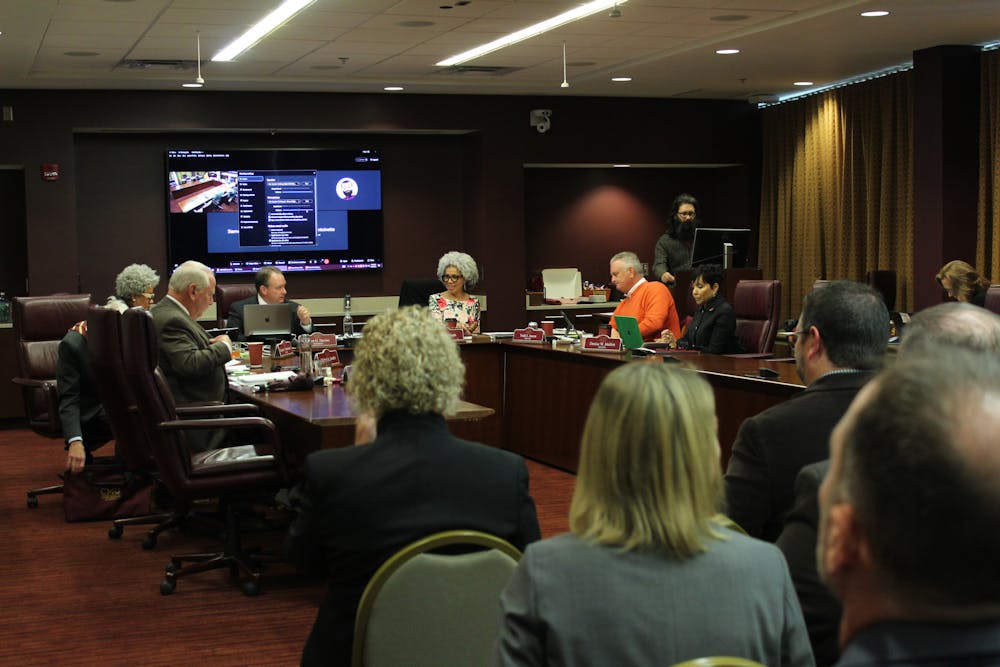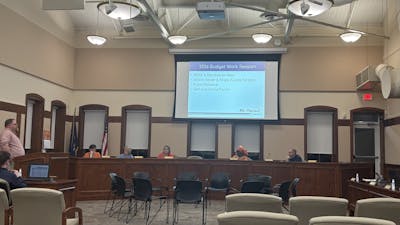'A tremendous undertaking': CMU’s strategic plan unveiled

When Central Michigan University President Bob Davies announced the university’s new strategic plan for 2023 to 2028 at the semester’s first Board of Trustees meeting, he outlined the proposed changes and priorities towards the goal of embodying the answer to one question:
“How does Central Michigan University become an educator, research institution and partner of choice in developing engaged and adaptive leaders who shape and serve the future of society?”
In the strategic five-year plan, which he referred to as a “tremendous undertaking (which required) hundreds of hours” of effort from faculty and students all across campus, he emphasized that the plan's vision is holistic and “not static.”
“It’s not about incremental growth in one area or another, it’s (about) how we do things better… how do we measure that from the impact?” he said.
As an aside, Davies presented his four ‘strategic priorities':
- Inspiring student success
- Engaging communities
- Enhancing organizational culture
- Ensuring institutional stability
Along with these, he presented numerical goals, both short-term and eventual, relating to each facet of the plan in the Sept. 28 meeting.
Defining success
Executive Vice President and Provost Nancy Mathews presented the board with a quote about the strategic plan, whose source she did not include:
“If we are a success, faculty, the student body and staff will acknowledge that they see themselves in the strategic plan and that they know this is the place they want to be and are excited by the vision rolling out over the coming years.”
When asked what kind of tangible changes students should expect to see as a result of the plan, Davies said there will be more of an emphasis on immersive experiences.
"One of our strengths is (our ability) to bring the real world to the academic world…,” he said. “The internships, the study abroad trips and various things along those lines, are amazing ways to enhance your educational opportunities, as well as the overall success as you proceed forward.”
To that end, in his presentation to the Board of Trustees, Davies also presented a goal of every graduating student having had “an immersive experience in a university-approved program” within five years. That includes a year-one target of establishing a comprehensive list of university-approved programs and a tracking mechanism with which to measure progress.
Reporting progress
“We talk about the implementation, which is an important part, but it’s also important to report on how the plan is progressing,” Davies said.
“The four (presented) priorities will guide the strategic direction of Central Michigan University for the next five years," Davies said. "Annually, the plan and allocation of resources will be reviewed, to ensure alignment between the budget and priorities.”
This, along with a deep dive after three years to adjust for issues and review the plan’s goals, allows for the plan to remain non-static and open to adjustments when required.
Enrollment down, but prospects looking up
Preceding Davies’ announcement, five committees presented the key points of their meetings the day prior, as well as highlighting other topics pertinent to their areas of focus. One recurring topic was the continuing drop in enrollment. However, that may be nearing a change, according to the statistics provided.
“Overall enrollment at the university (is down) by one percent,” Denise Mallett, the chair of the Academic and Student Affairs committee said, “Which equates to about 152 students, from the fall of 2022.
"In comparison, last year total enrollment was down 800 students, and the year (before) that was (a decline of) 1,200 students overall, so we’re making some headway there.”
Edward Plawecki, chair of the Finance and Facilities committee, echoed that sentiment.
“It appears our decades of enrollment decline at CMU are finally stabilizing,” he said. “We are moving in the right direction.”
President Davies was pleased with this trend as well.
“Our efforts to increase enrollment are clearly starting to pay off,” he said. “After more than ten years of enrollment decline, we began to turn the trend around last year… and we believe we are poised to have an overall increase (in new student enrollment) next year.”
AI remains a talking point
Another topic brought up by Sharon Heath, chair of the Trustees-Faculty Liaison Committee, continues to hold its status as a point of contention among faculty.
There are “emerging issues with AI in higher education,” she said. She still hopes to find ways to utilize it in classrooms, and prepare students for a world “shaped by AI.”
She, along with her fellow committee member Todd Anson, encourage faculty to learn about AI technology. She commented on the similarity past advancements in technology that now are a part of everyday life, such as phones, being as much of a novel sight as AI is today.
In addition, Heath mentions a host of resources for faculty and students to learn more about the subject, such as an AI bootcamp, workshops, web pages and more.
Though she recognizes concerns regarding cheating and how much of a students’ work is actually their own, she said, she emphasizes the importance of “empower(ing) faculty to prepare students for meaningful lives and productive careers in a rapidly evolving world shaped by AI.”
Orientation costs increase
A proposal from the Policy and Bylaws committee was also passed that would raise the cost of new student orientation from $175 to $200 per student.
This price increase, according to Davies, is to account for the cost of the orientation itself; the original price, he said, was not enough to cover the cost as it was.
Though this is the only time that the orientation price has been raised in 16 years, Davies said, it is unlikely to be raised again for at least several years going forward.






